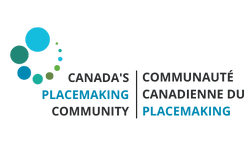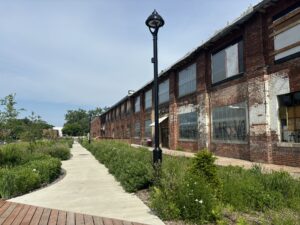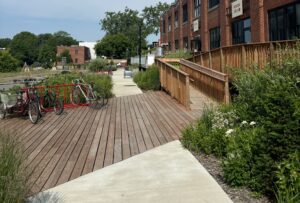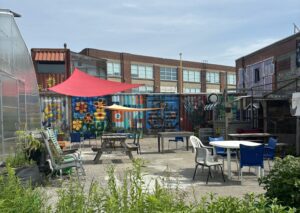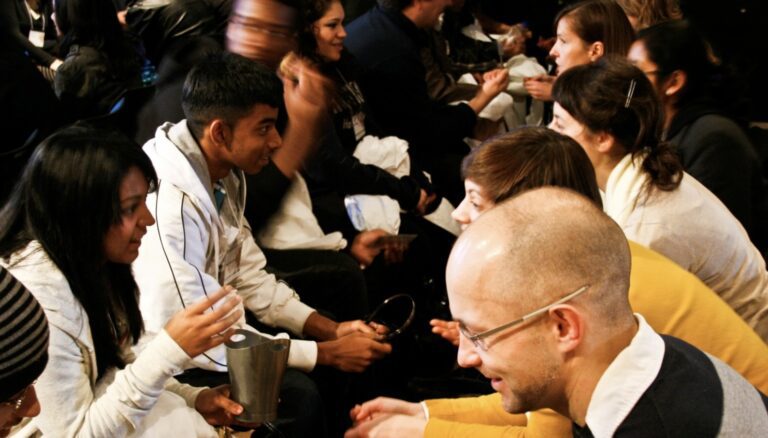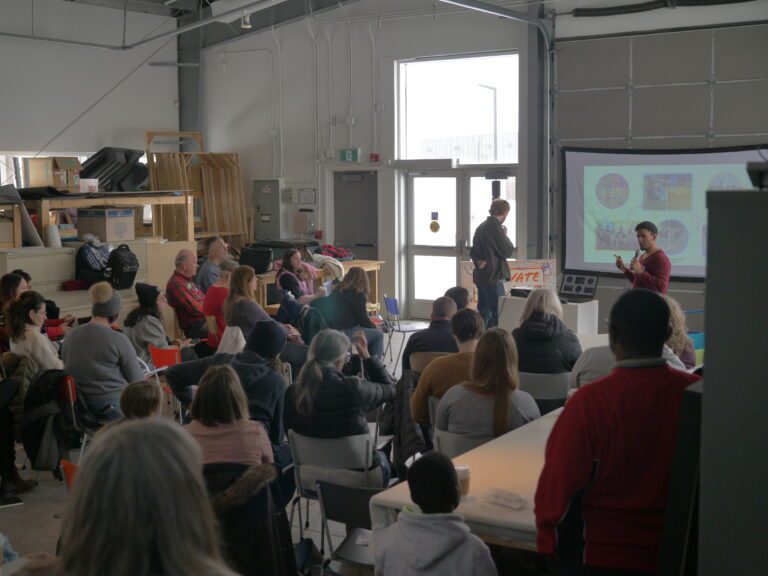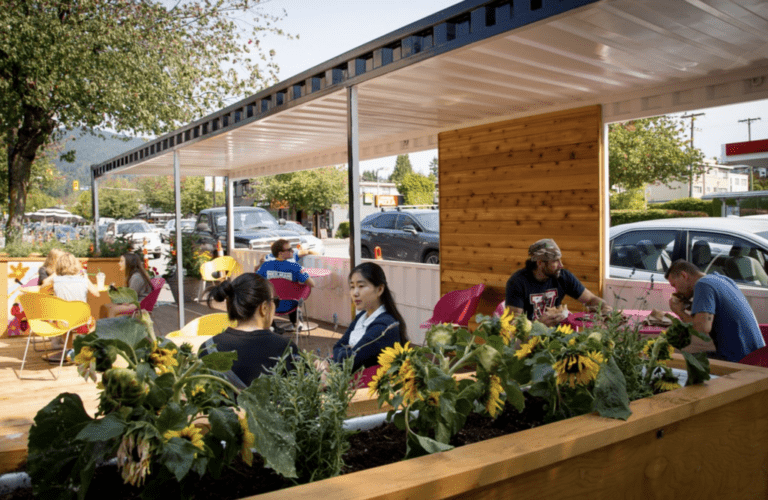In June 2024, representatives from the Healthy Communities Initiative (HCI) team and Canada’s Placemaking Community visited 7 A Nous, a collective in the Bâtiment 7 community hub in Pointe-St-Charles, Montreal. The HCI provided funding for the collective to develop a community garden project, a mini-farm, and multiple outdoor social activities and arts workshops. This project shows how placemaking by and for the community can build social ties, benefit the environment, and create a united vision for the future.
A Green Blueprint for Urban Space: Inside Montreal’s Bâtiment 7
By: Eva Morrison
Bâtiment 7 is a vibrant, sprawling brick building in Montreal’s Pointe-Saint-Charles neighbourhood at the edge of the St. Lawrence River. On the Tuesday morning of our visit, the place is buzzing with life.
It feels like every corner of the 90,000 square-foot building has a use: community members work on their cars at a solidarity-based associative garage, parts sit outside the bike shop to be upcycled, co-working spaces offer a reprieve from the summer heat, and people shop at the grocery store stocked with local products. Creativity is everywhere, with art overflowing from the studios specializing in metalwork, ceramics, printmaking, photography, and more. In the evenings, Bâtiment 7 becomes a lively social hub with a brewery, plays, and events filling the schedule.
We make our way to admire the HCI-funded Blue-Green Alley, an expansive bioretention project that grows plants with collected rainwater to reduce flooding. Nearby, people meet in the shade beside the greenhouse, while hens and rabbits roam the mini farm out back.
The Blue-Green Alley and walkway along the side of Bâtiment 7
Creating a Multi-Use Public Space
How did Bâtiment 7 become the multidimensional community-led space that it is today? The journey started in 2003, when a citizens’ flag was planted on the former CN grounds in Pointe-St-Charles. This marked the beginning of a rally to reclaim the industrial heritage site in Montreal’s South West. The 7 à Nous collective was formed, bringing together citizens, cultural organizations, community groups, and social economy entities with a shared goal: to transform the space into a community hub.
The group mobilization worked. In 2012, Bâtiment 7 was officially transferred to the community. The collective began converting it into a place to gather, create, and thrive.
Their mission is to maintain the neighbourhood’s history, respond to community needs, and promote a culture of autonomy and resource-sharing through democratic, inclusive management.
Recognizing the value of the Bâtiment 7 community centre, the Healthy Communities Initiative (HCI) granted 7 a Nous funding for safe and vibrant public spaces during the pandemic. This grant supported the implementation of Canada’s first Blue-Green Alley, enhancements to the on-site farm, and community workshops.
These placemaking initiatives blend climate action with creativity and social connection: art workshops use recycled and sustainable materials, community volunteers run the farm while building a sense of agency and neighbourhood pride, and a gardening club provides opportunities to make friends while learning about native plants. Addressing climate changes, urban isolation and loneliness, and the lack of accessible art spaces in the area all at once, this community-led placemaking benefits participants’ wellness in a myriad of ways.
Meeting Local Climate Needs
One of the most remarkable initiatives at Bâtiment 7 is Canada’s first Blue-Green Alley. The innovative project– a wooden walkway bordered by a range of plants– transforms a typical urban alley into a pleasant community space that supports stormwater management. When our team visited in June, the Blue-Green Alley was in full bloom, with lush greenery flanking the Bâtiment 7 building. Surrounded by the urban landscape of Pointe-St-Charles, the peaceful alley felt like a refreshing escape for residents.
Bikes are parked in front of the community bike repair shop at the beginning of the Blue-Green Alley.
The Blue-Green Alley incorporates ecological design principles to manage rainwater runoff. By directing water from downspouts into vegetated bio-retention areas, the alley reduces the amount of stormwater entering the municipal system. This not only alleviates pressure on the urban infrastructure but also helps to mitigate flooding and water pollution, key climate challenges facing the South-West of Montreal.
Cultivating Connection and Sustainability
At the end of the Blue-Green Alley is the community farm, another placemaking project supported by HCI. The HCI funding helped improve the farm area with a greenhouse, pergola, outdoor kitchen, and horticultural equipment. This transformed the farm into a welcoming space to learn hands-on skills–like gathering fresh eggs from the henhouse.
For community members in the urban neighbourhood of Pointe-St-Charles, the farm provides opportunities to connect with nature, learn about sustainable agriculture, and develop skills that promote self-sufficiency.
Cared for by volunteers, bunnies and chickens graze around the mini farm.
Fostering Accessible Creative Spaces
During the height of the pandemic in Montreal, HCI funding allowed the Bâtiment 7 programming to move outdoors. This was especially valuable for marginalized community members facing social isolation with the closure of activities in the area.
In the fall of 2021, the Buckskin Babes collective hosted traditional moose hide tanning practices guided by a knowledge keeper. Using all parts of the moose, the collective invited Indigenous groups and students to a day-long learning session to create tools, treat the hide, and make rattles out of the hoofs.
The HCI also funded “Plein AiRT,” a series of nine outdoor arts workshops with natural themes, like watercolours and botanical illustration. In collaboration with local organizations such as Press Start, Maison St-Colomban, and École St-Gabriel, these activities engaged 91 community members. The workshops significantly strengthened community ties and brought much-needed positive energy during the challenging pandemic period, with participants of all ages joining in.
A communal area where barbecues, film screenings, club meetings, and outdoor activities are hosted.
Placemaking with a Shared Vision for the Future
Bâtiment 7 is an impressive model of community-led placemaking that centres on the neighbourhood’s needs. With human relationships at its core, the project fosters pleasant, safe, and accessible spaces. Holistic projects like this one can help communities face specific environmental and social challenges with collaborative action for a sustainable future.
To learn more about Bâtiment 7, visit their website, explore the space, or support their efforts by getting involved.
Canada’s Placemaking Community builds capacity for national placemakers by sharing impactful stories, convening in-person and virtual events, and commissioning research. By fostering collective action, we aim to drive better public outcomes and create vibrant, equitable public spaces for all. Discover more projects in our community of practice and learn more about the benefits of community-led placemaking in the Power of Placemaking Research Report, developed in partnership with Happy Cities.
